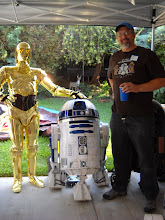
Once the glue had set up on these, I laid them out with the various measurements:

The layout is pretty simple despite the appearances here. I need reference lines at a 90 degree angle so that these can be lined up on the frame. I want the top dead center of the hubs to line up to top dead center on the frame.
But the out legs are canted back from vertical by 36 degrees. So I drew one cross on these hubs, then I drew another one tilted off of it at 36 degrees. Then I can just put the square bolt pattern onto that second tilted square. Next step is to rough the circles out on the band saw:

This step won't be easy to duplicate for people without the equipment. I've got a 220 volt heavy duty band saw that is designed for doing resawing, and cutting these corners off was pretty hard work. I probably wore out one of my last good blades on it. Lots of heat. There's almost 3 inches of solid plywood here with lots of glue layers. That's hell on woodworking equipment. But I got them off. I'm trying to think about other options for builders who don't have a suitable band saw. There's always hand sawing, although I try to avoid that when I can. You might be able to set the blade on a decent circular saw down 1.5" or so and then do multiple corner cuts on the top and bottom and just carve them off. Be careful and secure the work piece. The reason I'm intent on doing the rough cut is to make less work and less dust creation at the belt sander next.
I realized that I've been talking about the belt sander a lot and it probably sounds like I mean one of these:

(On a side note: to my horror, I found out that a lot of the storm troopers who are carving blanks of MDF to make molds for their storm trooper armor and just going to work on the MDF with one of these and carving away. But MDF has a number of chemicals in it that are carcinogenic and the dust is really bad news. If you use a belt sander on it without some protective gear and a dust collection system you'll get a lot of it in your lungs. I've made my eyes and throat pretty irritated with it too. Back to the topic:)
But I mean the stationary belt sander when I say that. Here's my rig:

I know I have digressed about tools here a bit, but it's necessary. This is another 220 volt machine with a 6 x 48" belt and adjustable angle table. With that much power, nothing bogs it down. And it's precise enough for me to do a lot of finish work quickly with it. Having good tools pays for itself over and over. This, like the band saw, is a Grizzly. I've had really good luck with them--cheap and high quality. Even with shipping, their prices are better than the main line brands you see.
So I put a rough belt on there--100 grit--to make the rough work go fast, and rounded these hubs out. A word about sandpaper grits. Get the right grit for the job and be willing to pitch the old stuff when it gets worn out. If you're doing big rough stuff, use a low grit. There is no sense in wasting hours and hours scrubbing away at some big job with a worn out piece of 220 grit. The new 100 grit belt on here took these hubs down to the circle line in about 10 minutes total or less for both of them.

Now I can drill out the holes for the leg bolts to go through and the center hole for the wiring.

The bolt holes are 1/2". The bolts are 3/8", so that allows 1/16" of wiggle on either side. And I just used a 3/4" paddle bit for the center hole. That could be bigger to save some weight--2 inches would be nice. But that was more work that I wanted to do on this.
These should line up nicely with the bolt holes on the legs:

Speaking of the legs. You can see here that I've started laying on some bondo and filler in the gaps, holes, and tear outs on the legs. Here I've gone back after the bondo has set and sanded it down flush with an orbital sander and 220 grit disks. That should solve the tear out problem I've been having with this fancy plywood.
Only a few steps remain before these legs are ready for primer (and shipping): 1) rout out the recessed circles in the middle of the shoulder for the shoulder hubs, 2) drill the axle holes in the tips of the outer legs, 3) attach the curved outer ankle pieces, 4) add touch up filler and finish sand the whole leg down to 320 or so.







No comments:
Post a Comment